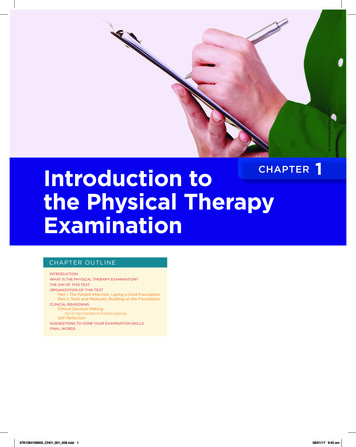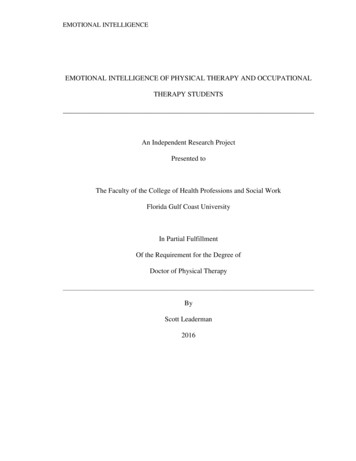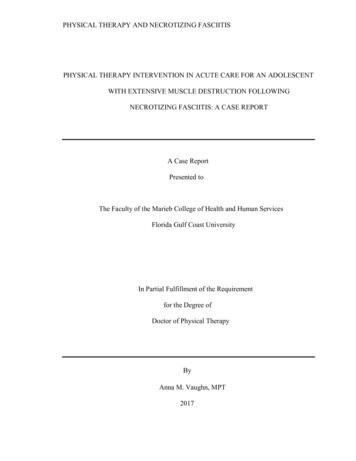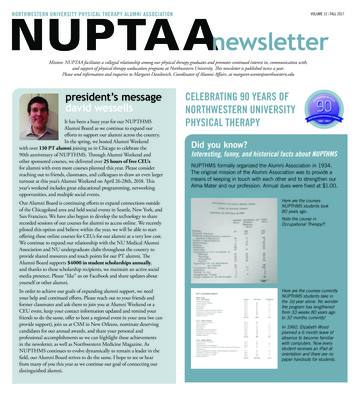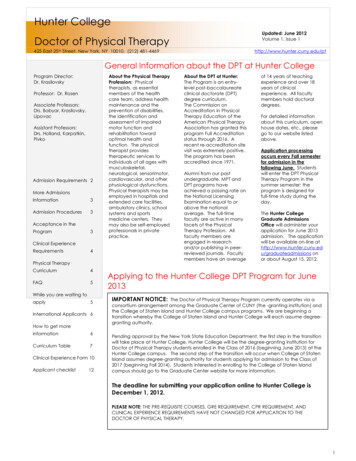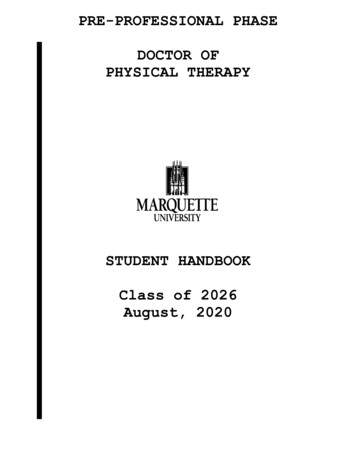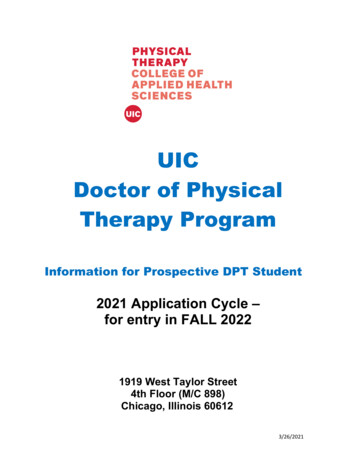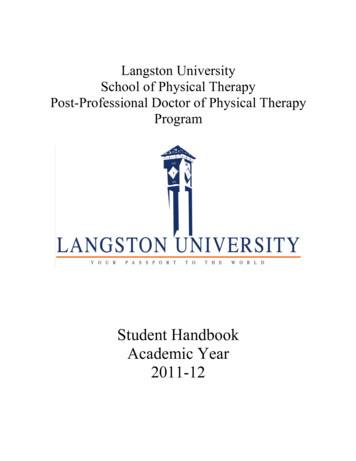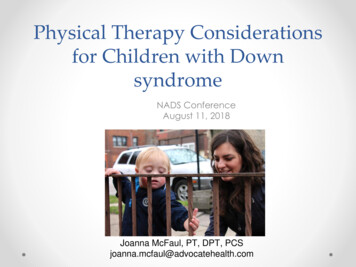
Transcription
Physical Therapy Considerationsfor Children with DownsyndromeNADS ConferenceAugust 11, 2018Joanna McFaul, PT, DPT, PCSjoanna.mcfaul@advocatehealth.com
The Big PictureThe focus of physical therapy is develop a bodythat is fit and functional for a lifetime Reducing unhelpful compensations Encouraging Participation Possibly accelerating the rate of milestones
Settings for Physicaltherapy Neonatal Intensive Care UnitEarly InterventionSchool-basedInpatient hospital or rehab hospital (acute care)OutpatientWellness groupsSpecialty Clinics
When does my child needPT?When they are working towards achieving a newgross motor skill or participating in a sportWhen their gross motor limitations are impacting theirsafety or participation in school, recess or in gym classAfter an orthopedic surgeryWhen musculoskeletal pain issues arise
Musculoskeletal FactorsLow Muscle Tone (hypotonia)- a low level of musclecontraction during a resting state; limited resistance topassive movement of a muscleAffects all areas of the body, including oral motor skillsand intestinal motility
Musculoskeletal Factors Ligamentous Laxity (Loose ligaments)o Decreased collagen fibers Decreased Strength Delayed skeletal maturationo Short arms and legs
Musculoskeletal FactorsHypotoniaStrengthLigamentous Laxity
Underlying Causes of MotorDifficulties1. Cerebellum hypoplasiao muscle hypotoniao axial control of the trunko body balanceo coordinationo speech disorders2. Corpus Callosum sizeaffect coordination3. Other health concerns orillnesses
Associated Conditionsthat may affect mobility ObesityHearing and vision lossCardiac abnormalitiesDecreased mobility from surgerySeizuresSleep apneaEar infectionsChronic upper respiratory problems
Motor LearningConsiderations1. Reduce hands-on support when safe toavoid dependence2. Practice new skills in new environments3.Provide visual and tactile cues
Motivation Strategies Visual Scheduleso Shows the order of activities during therapy
Motivation Strategies Token Chartso Child works for an object or activity by rewarding adesired behavior
Motivation Strategies “First , Then ” Visualo Shows something the child prefers that they willget after completing a less preferred task
Movement Patterns Decreased kicking in infancyWide-base of support with all activitiesMovement in straight planesCo-activation of muscles for stabilityLatent (delayed) muscular responsesRequire more time to learn movementas movement complexity increases(Palisano, 2001) Slowness of movement Less precise, coordinated & efficient
MilestoneRolls to proneKids withDownsyndrome(Median)7 monthsRange withDownsyndromeTypicallyDeveloping(Median)5-9 months7 monthsSits unsupported 10 months8-11 months7 monthsCrawls14 months9-19 months8 monthsPulls to Stand15 months8-26 months8 monthsStands Alone18 months12-38 months11 monthsWalks Alone23 months13-48 months12 monthsRuns4 yearsNA1 ½ yearsJumps4-5 yearsNA2 yearsDeveloped from Winters, 1997 and Pereira et al, 2013
Probability of AchievingGross Motor Skills Palisano et al, 2001Study of 121 children, showing percentage of childrenwho reached these milestones by age in 235812254567Jump000125185284
Orthopedic IssuesGreen, 2008 Scoliosis (thoracogenic)o8.7% (Milbrandt & Johnson, 2005) n 379 Arthropathy similar to ArthritisoPolyarticular (in 1 joints) with subluxation,1.2% (Olson, 1990)
Orthopedic Issues Hip issueso Hip dislocation/dysplasia, symptomatic 2-10 years withlimp, poor gait, pain, 1.25-7%o Slipped Capital Femoral Epiphysis 1.3%, Perthes 2%o Progressive hip instability after skeletal maturity
Orthopedic Issues Patellofemoral (knee)Instabilityo 20% instability, 4-8% dislocation Pes planus (flat feet) Osteoporosis, lower BoneMineral Density even atyoung age (Center, 1998)which can lead to fractures
Atlanto-Axial Instability 15-20% have subluxation, 1% is symptomatic Symptoms:o Neck pain/stiffness, cervical deformity, headache,extremity pain, deterioration of gait, spasticity,hemiparesis, hyperreflexia, bowel/bladder changes Could cause acute cord compression or suddendeath X-Ray Screenings?oAAP no longer recommendsoSpecial Olympics requires Separhi et al, 2005 and Bull 2013
Atlanto-Axial InstabilityAvoid manipulation or “adjustments” to cervical spineMay require radiographs before anesthesia or beforeplanned intubation (emergency intubation requirescaution for neck position)Avoid football, gymnastics, trampolines, 54overview#a1
Exercise Capacity Adults with DS have lower cardiovascular capacity withlower mean peak Oxygen consumption, minuteventilation and heart rate during exercise (Pitetti, 1992) Contributing factors:o Lower lean body muscle masso Lower muscle strengtho Thyroid disorderso Hypotonic muscle toneo Obesityo Impaired sympathetic response to exerciseBarnhard & Connolly, 2007
Assessment Tools Test of Infant Motor Performance Alberta Infant Motor Scales Peabody Developmental Motor Scales Gross Motor Function Measure Pediatric Evaluation of Disability Index Timed up and Go Test (not Timed Up and Downstairs) Pediatric Balance Scale
Impact of ExerciseChinxiao et al, 2013 Review of 10 RCTs Four different fitness outcomesreported in studies:ooooBalance (4 studies)Muscle strength and endurance (7 studies)Cardiovascular fitness (2 studies)Body composition (3 studies)
Treadmill Training inInfancyUlrich 2001o 30 subjects, RCTo TT from sitting unsupported until3 independent stepso Home treadmill for 8’ per day5x/wko TT group walked 101 daysearlier (ave 20 mo v. 24 mo)Higher intensity helps reach 6 othermotor milestones and walking even2 months before low intensity
Bicycle Training
OrthoticsUsed to improve “flat feet” (pes planus), improvepostural stability, balance and motor skillsMost commonly used are SupraMalleolar Orthotics(SMOs) or customized foot orthotics as kids get older
Results of Using SMORandomized controlled trial of 14 kids with DS,ages 3.5-8 yo Improvement in balance (p .027) Improvement in gross motor skills on thestanding, walking, running (p .001)and jumping(p .0001) sections of the GMFM(Martin, 2004)
OrthoticsBefore walking? Looper, Ulrich, 2010o Infants with DS who used SMO pre-walking had lowerscores on the GMFM one month after onset ofwalking than those who did not use SMOs No difference in onset of walking betweengroupsHowever,Some infants won’t be able to stand without orthotics
Other InterventionsHip HelpersAbdominal Binder
Assessment Tools Test of Infant Motor Performance Alberta Infant Motor Scales Peabody Developmental Motor Scales Gross Motor Function Measure Pediatric Evaluation of Disability Index Timed up and Go Test (not Timed Up and Down stairs) Pediatric Balance Scale


